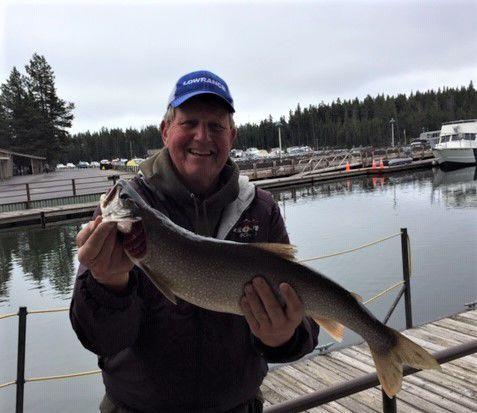Many of you have thanked me for sharing the information about the cutthroat trout recovery in Yellowstone Lake, in Yellowstone National Park. I appreciate your kind words.
The week, allow me to explain just what the cutthroat eat in Yellowstone Lake, and then I’ll suggest several spots (from the shore) for you to target and hopefully connect with some of these delightful fish.
Yellowstone cutthroat are known to eat aquatic insects, minnows (sculpin, sucker, whitefish) and leeches. But, since we can only catch and release these fish, figuring out what’s in their stomachs is a bit challenging.
Yes, I know fly anglers “pump” trout stomachs to find out what they are eating but I do something different.
The best method right now (for me) of discovering what cutthroat are eating is to catch a lake trout. Lake trout do (at times) intermingle with the cutthroats. We noticed just a few weeks ago that schools of lake trout would move close and feed in the same areas as the cutthroats. When we caught those lake trout, we quickly realized after cleaning them, that they were stuffed with black leeches.
This would play well to a possible fishing approach if I were to go back into my childhood memories when my father taught me which flies to use on Yellowstone Lake.
“Son,” he said, “start with a back woolly worm (woolly bugger) and end with one.” Leeches are plentiful and are apparently easy prey.
If you are planning a trip to Yellowstone National Park and want to catch a Yellowstone Lake cutthroat, here is exactly what you need to do.
First, take along the following lures: Jake’s Spin-a-lures in several sizes, Kamlooper(s) in red and gold and yellow and gold in the 3/4-ounce size, medium sliding bubbles, eight-pound-test leader material, medium safety pin swivels, and finally, black, brown, and green leech pattern sinking flies (wooly buggers and wooly worms). Remember to pinch down the barbs (or find barbless hooks).
Next, stop by one of the general stores or a ranger station and purchase a fishing license. A three-day permit costs $18. If you have teenagers 15 years or younger, they do not need a permit if fishing with a responsible adult who has a valid fishing license.
Take those lures and go to the following spots (three of my favorites) near the Bridge Bay, Lake, and Steamboat Point areas of the lake.
1. Sand Point
Located just a few miles towards West Thumb from Bridge Bay, a parking lot gives you access to a trail down to the lake where you will find a long sandy beach heading toward a main point. Fish anywhere you can make a cast, first with the fly and bubble rig (48-inch leader), and secondly, (closer to the main point) any of the other lures suggested above.
2. The Meadows
Just across a meadow from Bridge Bay Campground, this spot holds some nice cutthroats and they can be caught by making long casts from shore, first with any of the lures mentioned above, and then with the fly and bubble rig (48-inch leader) early and late.
3. Steamboat Point
There is a small turnout just before coming to Steamboat Point on the right side of the road (heading towards the east entrance). From there, head down to a point of large boulders heading out from shore. Cast a fly and bubble rig (48-inch leader) in early morning and late evening or any of all of the other lures throughout the day.
Catching and releasing one of these special fish is a bucket list experience for many anglers.
If you give it some time, one to two hours in the early morning and a couple of hours in the evening or even a few hours in the late morning or early afternoon, I am confident that with the above-mentioned lures, flies and areas to fish, you too can catch Yellowstone cutthroat trout on famed Yellowstone Lake.
Credit: Source link































